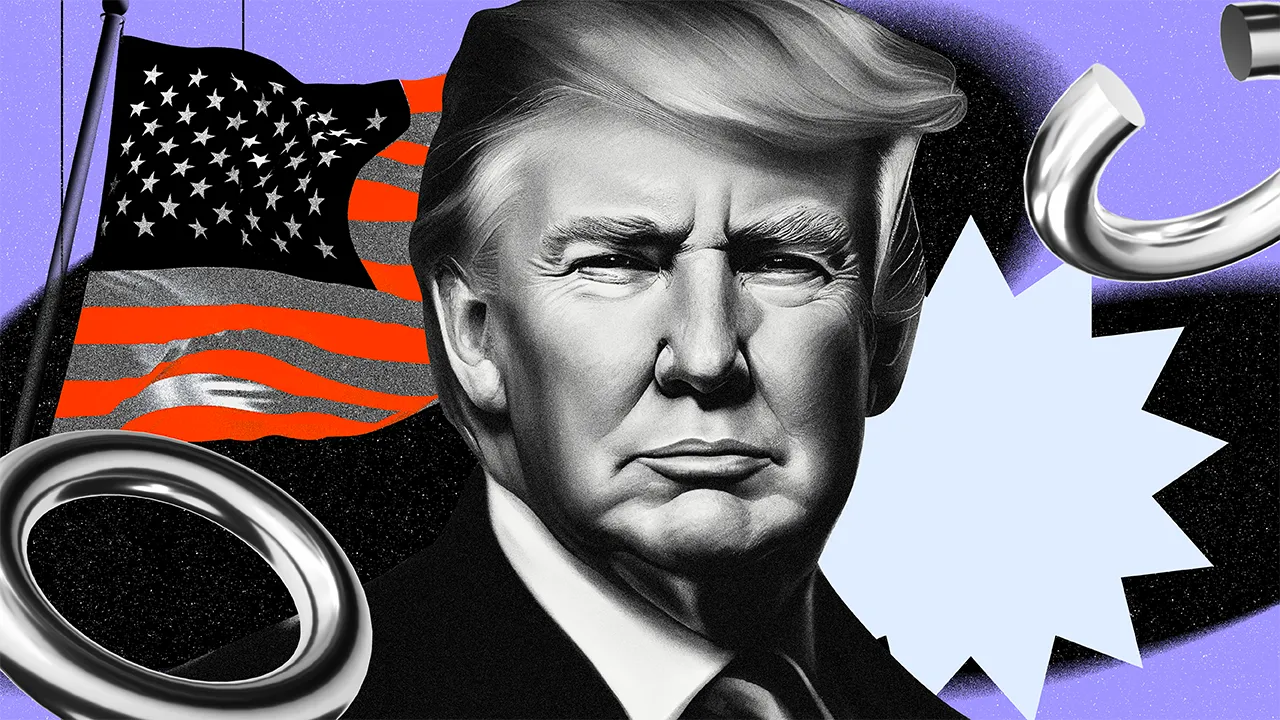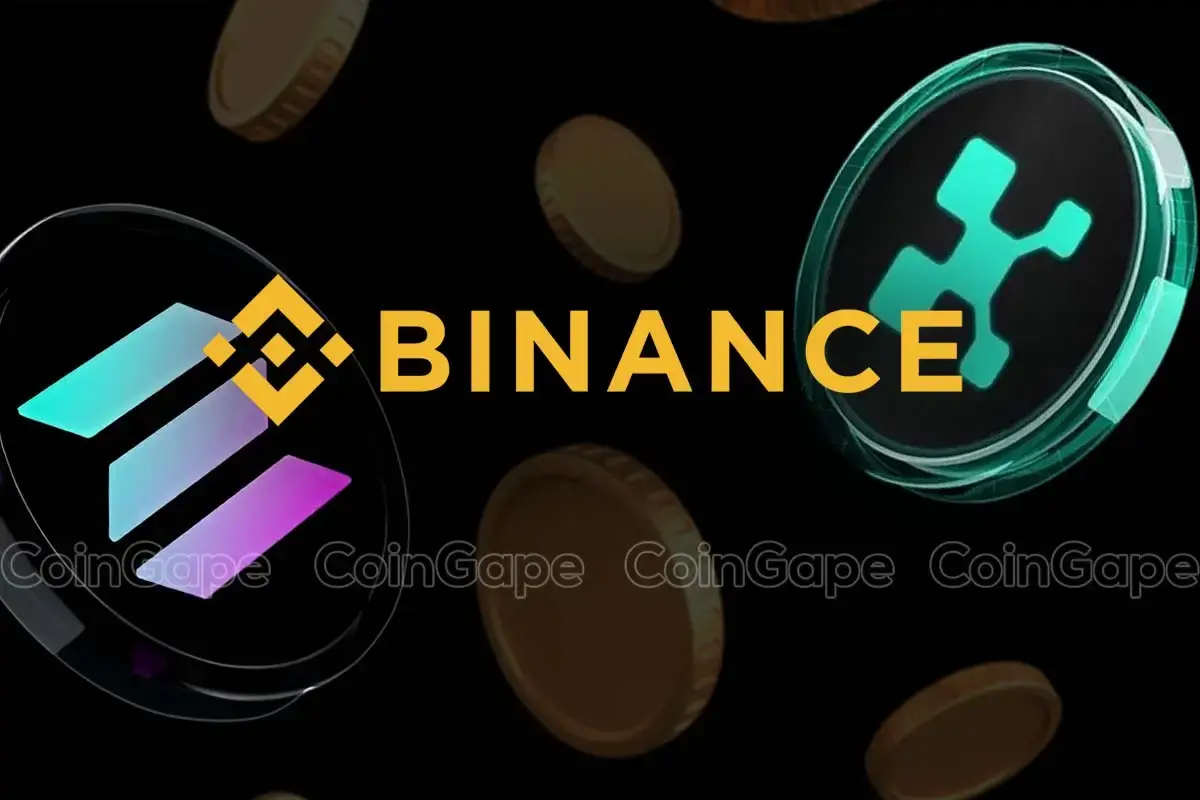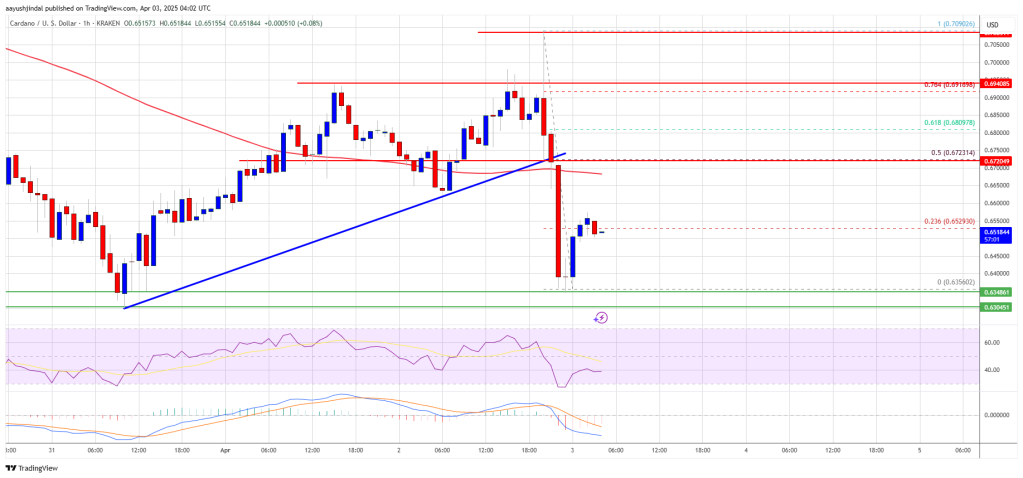Market
A Distant Threat or Imminent Reality?
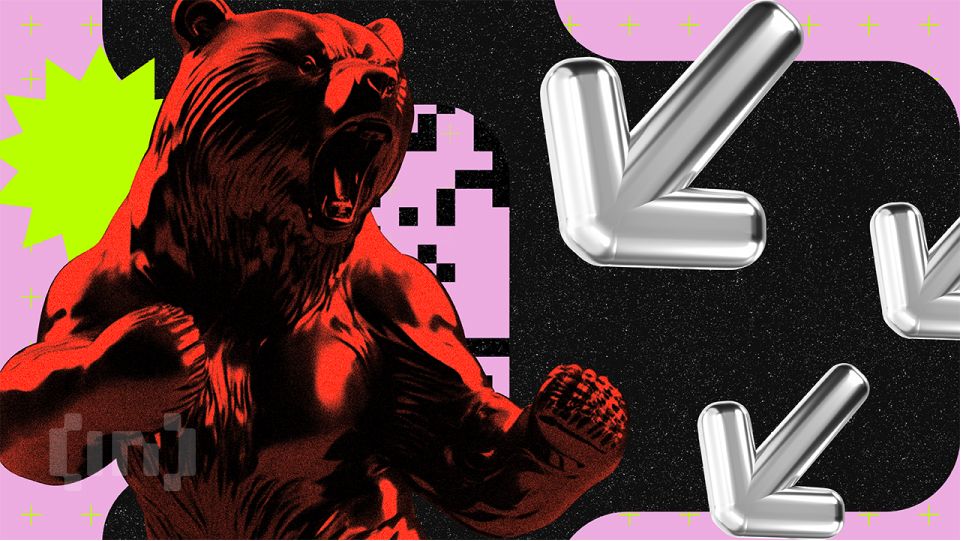
On average, a crypto bear market lasts about a year, sometimes extending to two. This phase occurs when supply surpasses demand, causing prices to decline over an extended period.
One of the most severe bear markets unfolded in 2022. During this time, FTX, one of the largest crypto exchanges by trading volume, collapsed following a massive bank run. The downfall triggered a ripple effect, leading to the collapse of several hedge funds and lending protocols, marking a significant low point for the industry.
Bear Market Psychology Explained
Recently, there’s been talk about the crypto market heading back into a bear phase. Many cryptocurrencies have struggled since Bitcoin (BTC) hit $73,750 in March. The decline has raised concerns that the market might be entering another long period of falling prices.
The event, which surprisingly happened before the halving, sent shockwaves around the market. At that time, many suggested that crypto prices would hit higher highs.
However, this has not been the case. Instead, BTC’s price, alongside other cryptocurrencies, has either been consolidating, falling, or involved in false breakouts.
These factors, among others, have led some participants to suggest that the market might be heading into a bear phase. To evaluate this possibility, BeInCrypto examines the market cycle psychology chart for insights.
Read more: How To Make Money in a Bear Market
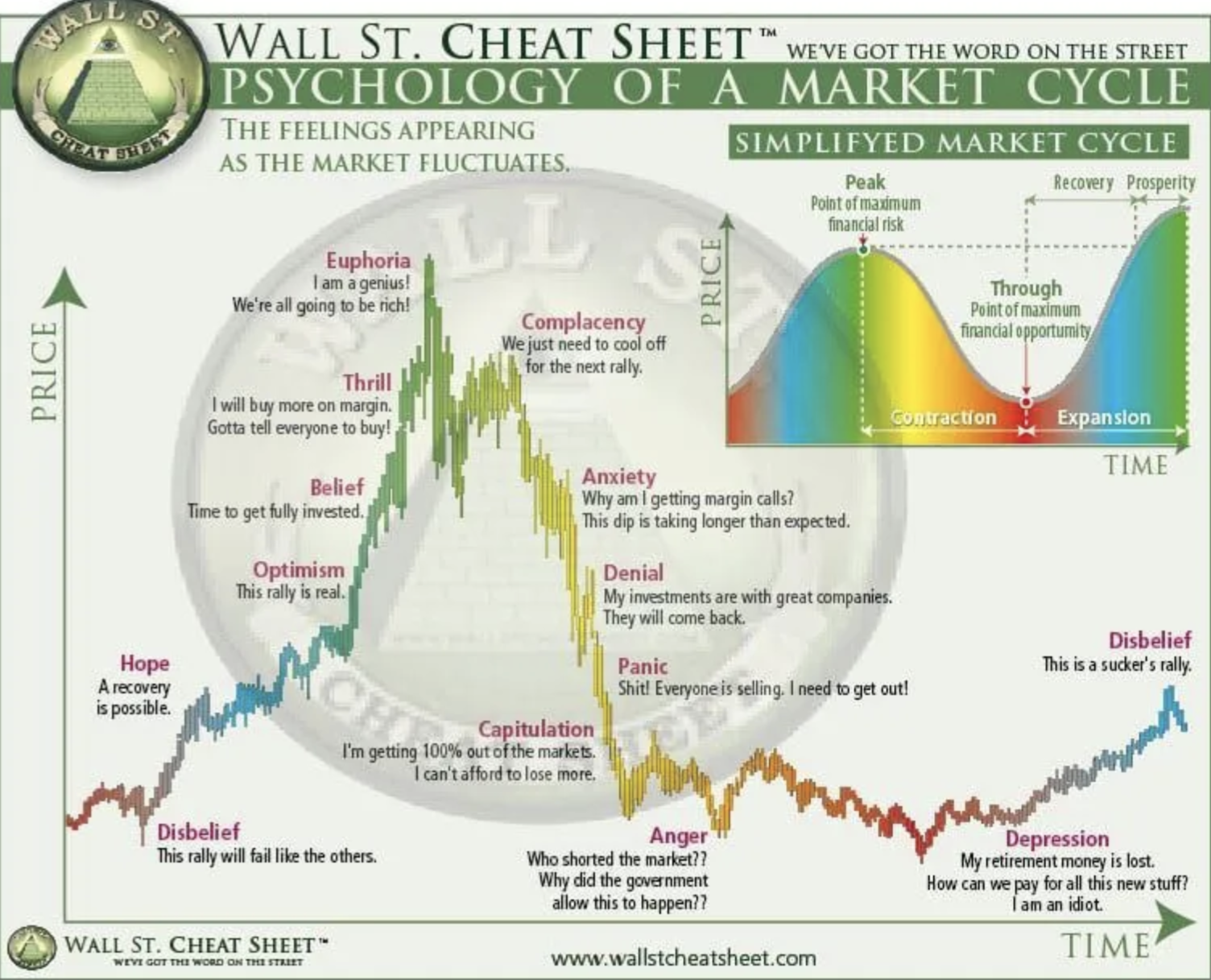
As seen above, this chart shows 14 different stages. For instance, the disbelief marks the end of the bear market when cryptos begin to move into the bull phase. There are also phases of thrill, anxiety, euphoria, or complacency.
From the look of things, the disbelief stage happened around the first quarter of 2023, when the Bitcoin price began to post gains consistently. Meanwhile, the “Thrill” period probably happened during the ETF approval earlier in January this year, as there were calls for people to double down on buying BTC.
Euphoria probably occurred in between March when BTC and many other altcoins and meme coins reached different heights. The cool-off in recent times may suggest that this cycle is between complacency and anxiety, which usually precedes a bear market.
Bitcoin Holders Say a Big No to the Downturn Despite ETH Issues
However, the periods of complacency and anxiety may have been false alarms. According to Glassnode, the Bitcoin Long-Term Holder Sell-side Risk Ratio offers a clue. This metric measures the level of profit-taking compared to past market cycles.
Currently, the ratio remains below the peak seen during the 2021 bull market, indicating that long-term Bitcoin holders are refraining from selling.
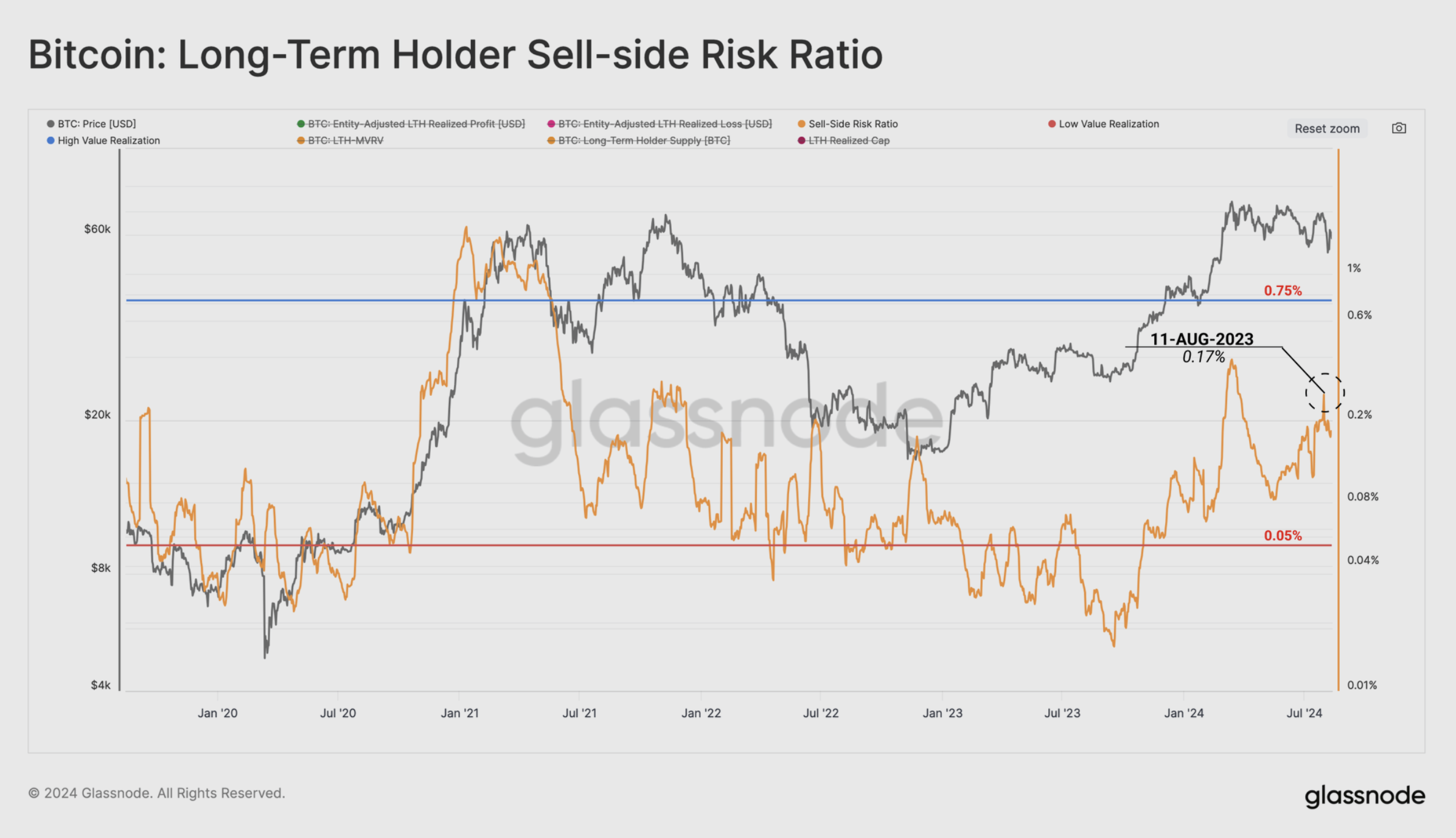
Actions like this suggest high conviction among long-term holders. With respect to this, the on-chain analytic platform explains that:
“An elevated percentage of Bitcoin network wealth is held by this investor cohort relative to previous cycle ATH breaks, which suggests there is a degree of investor patience on display, and waiting for higher prices.”
If this holds true, the bear market might not be imminent, and the cycle could still be in its bear phase. However, some market participants remain skeptical due to the underperformance of certain altcoins, particularly Ethereum (ETH).
In 2021, after Bitcoin reached its all-time high (ATH), ETH quickly followed suit and surpassed its previous peak. This time, however, the situation is different, even with the launch of spot Ethereum ETFs.
Currently, ETH trades at $2,657, marking a 45% drop from its ATH. Earlier, many market participants confidently predicted that the altcoin would reach between $8,000 and $10,000, but those expectations have yet to be realized.
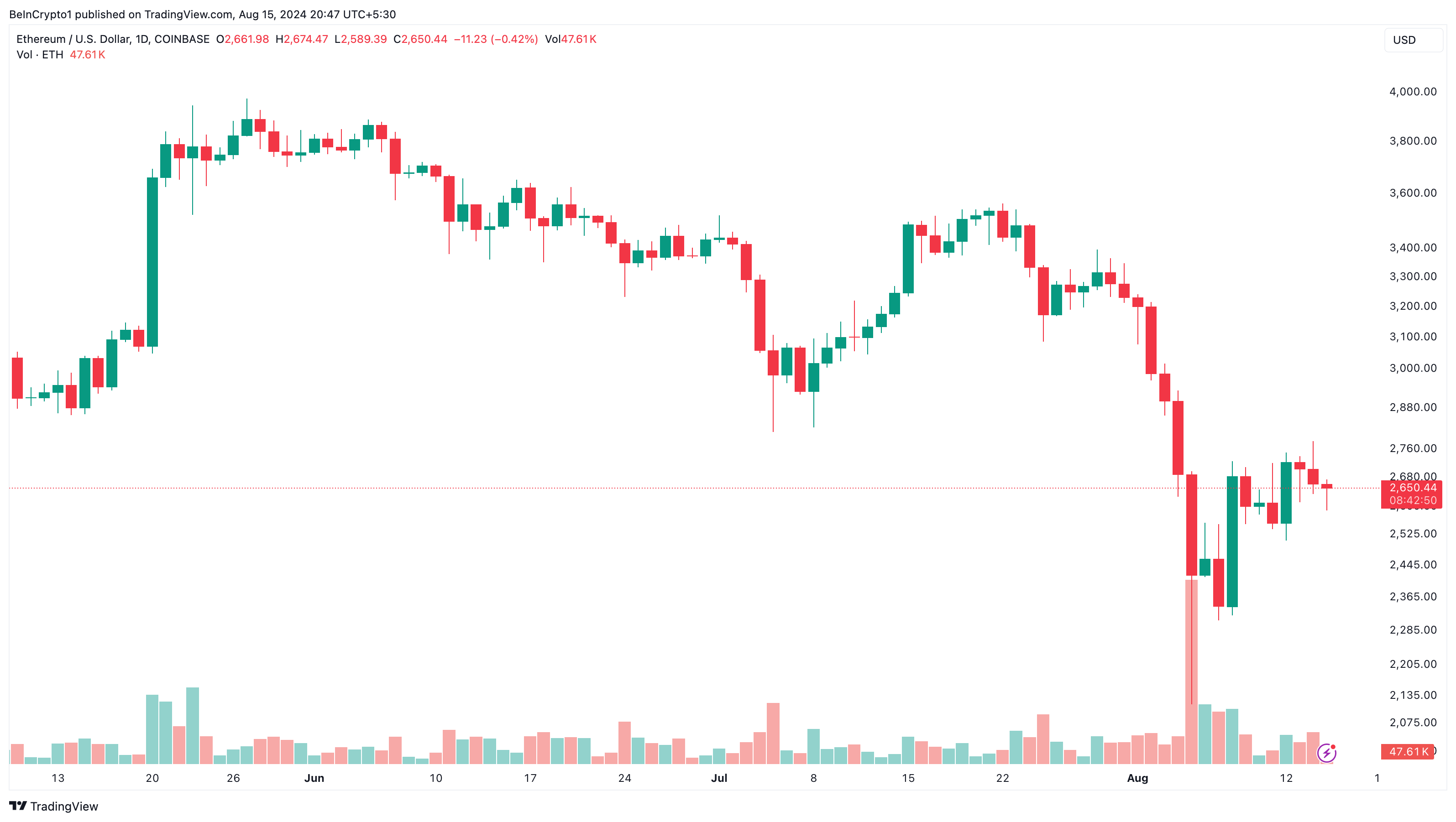
Some of those optimistic predictions have faded as ETH continues to underperform, strengthening the belief that a bear market is approaching. However, it’s important to recognize that top cryptocurrencies, including BTC and ETH, recently underwent a period of distribution, which contributed to the recent price correction.
Bears Are Still Lurking for a Crypto Winter
Market participants might also worry that crypto whales have slowed down on buying BTC. However, these pauses are typical during a bull cycle. Despite this, caution is advised, as indicated by the Net Unrealized Profit/Loss (NUPL).
The NUPL measures whether investors are in profit or loss. When the reading increases, it shows that more investors are seeing higher profits. Conversely, a decrease signals declining gains.
This metric also helps determine whether the market has entered a bear phase. An increase points to a stronger bull cycle, while a significant decrease raises the likelihood of a bear market.
Read more: Bitcoin Halving History: Everything You Need To Know
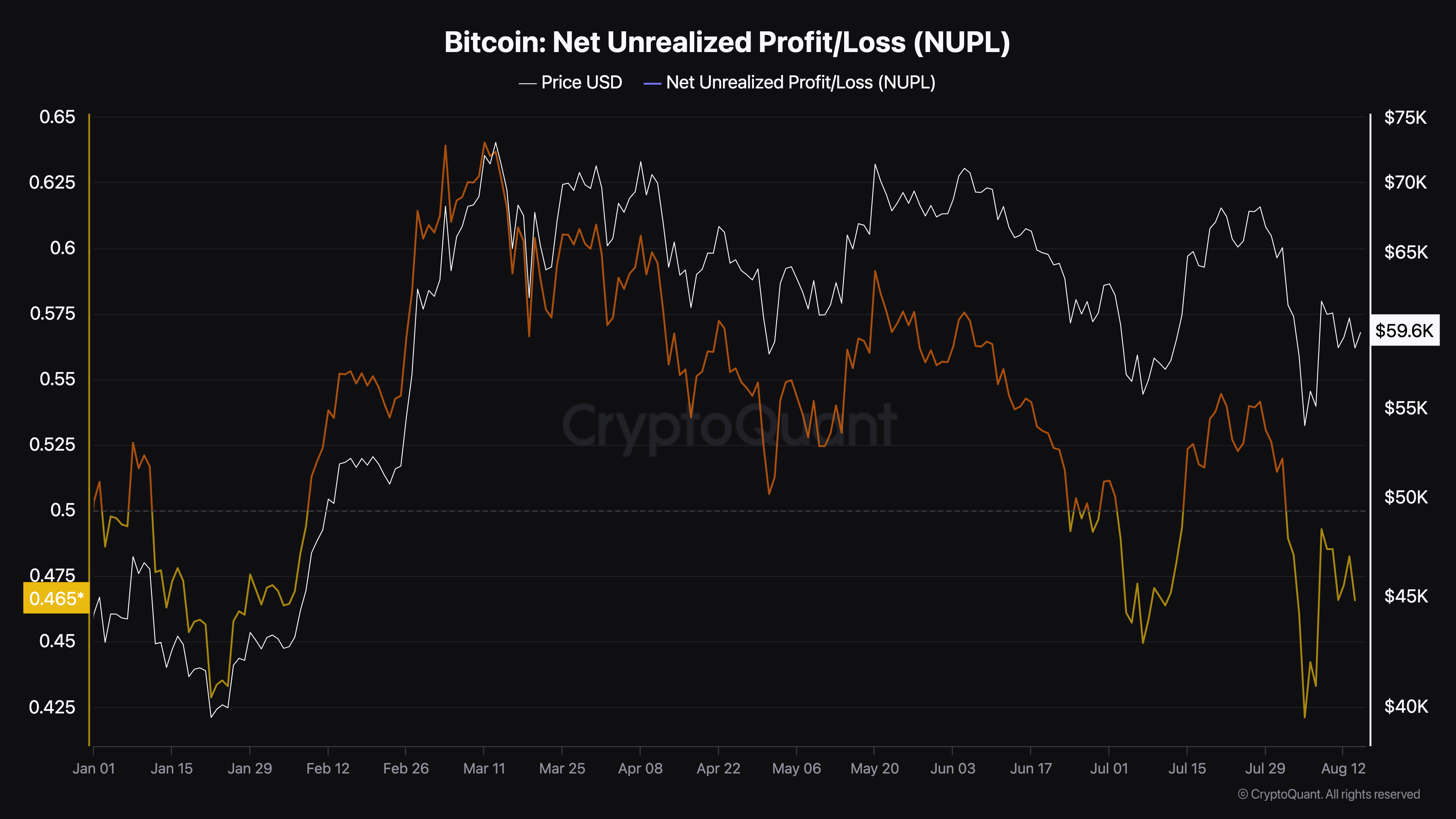
At press time, Bitcoin’s NUPL stands at 0.46. In July, a similar drop in this range led BTC’s price to decline to $55,857. The last time the indicator hit this level, Bitcoin’s price fell to $42,576.
This makes the current reading a critical point for the market. If the NUPL continues to decrease and reaches 0.40 or lower, bears could take control. According to Grizzly, a pseudonymous analyst on CryptoQuant, if that happens, BTC could potentially drop to $40,000.
“If the index continues its downward movement, it’s reasonable to anticipate that the bears could take full control of the market. In such a scenario, the price could drop to around $40,000,” Grizzly wrote in his analysis.
Disclaimer
In line with the Trust Project guidelines, this price analysis article is for informational purposes only and should not be considered financial or investment advice. BeInCrypto is committed to accurate, unbiased reporting, but market conditions are subject to change without notice. Always conduct your own research and consult with a professional before making any financial decisions. Please note that our Terms and Conditions, Privacy Policy, and Disclaimers have been updated.
Market
Ethereum Price Recovery Stalls—Bears Keep Price Below $2K
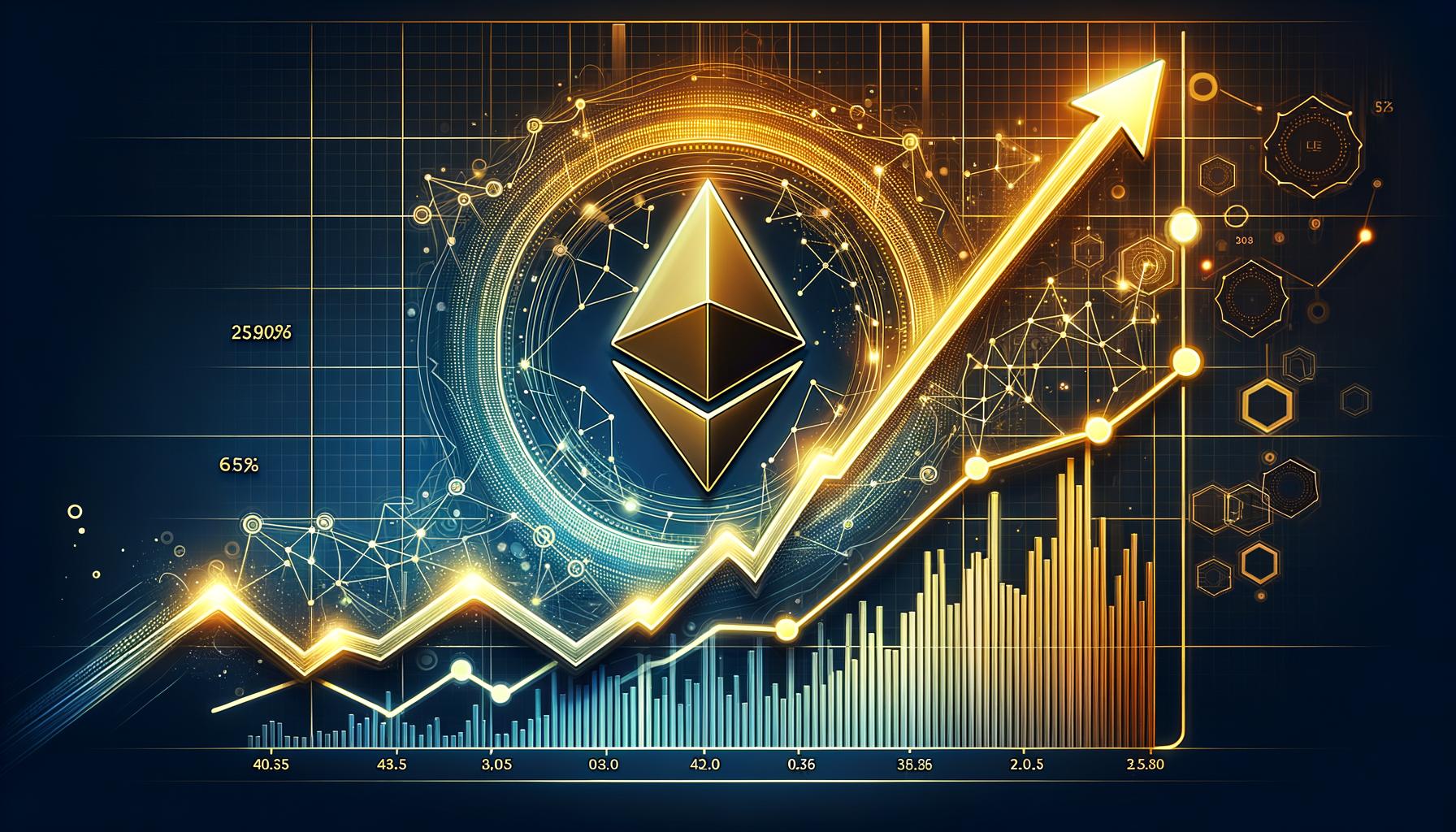
Reason to trust

Strict editorial policy that focuses on accuracy, relevance, and impartiality
Created by industry experts and meticulously reviewed
The highest standards in reporting and publishing
Strict editorial policy that focuses on accuracy, relevance, and impartiality
Morbi pretium leo et nisl aliquam mollis. Quisque arcu lorem, ultricies quis pellentesque nec, ullamcorper eu odio.
Ethereum price attempted a recovery wave above the $1,880 level but failed. ETH is now trimming all gains and remains below the $1,880 resistance zone.
- Ethereum failed to stay above the $1,850 and $1,880 levels.
- The price is trading below $1,850 and the 100-hourly Simple Moving Average.
- There was a break below a key bullish trend line with support at $1,865 on the hourly chart of ETH/USD (data feed via Kraken).
- The pair must clear the $1,865 and $1,890 resistance levels to start a decent increase.
Ethereum Price Fails Again
Ethereum price managed to stay above the $1,800 support zone and started a recovery wave, like Bitcoin. ETH was able to climb above the $1,850 and $1,880 resistance levels.
The bulls even pushed the price above the $1,920 resistance zone. However, the bears are active near the $1,950 zone. A high was formed at $1,955 and the price trimmed most gains. There was a break below a key bullish trend line with support at $1,865 on the hourly chart of ETH/USD.
A low was formed at $1,781 and the price is now consolidating near the 23.6% Fib retracement level of the downward move from the $1,955 swing high to the $1,781 low.
Ethereum price is now trading below $1,850 and the 100-hourly Simple Moving Average. On the upside, the price seems to be facing hurdles near the $1,850 level. The next key resistance is near the $1,865 level and the 50% Fib retracement level of the downward move from the $1,955 swing high to the $1,781 low.
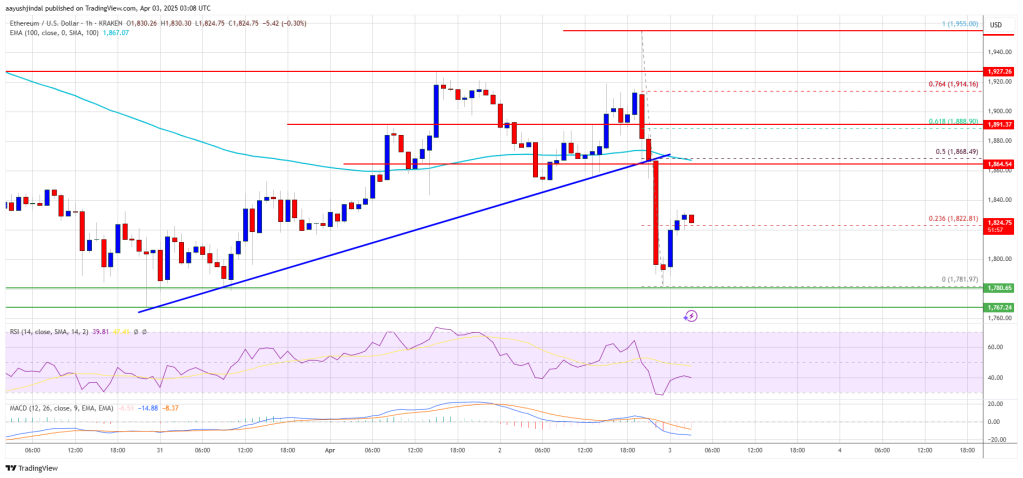
The first major resistance is near the $1,920 level. A clear move above the $1,920 resistance might send the price toward the $1,950 resistance. An upside break above the $1,950 resistance might call for more gains in the coming sessions. In the stated case, Ether could rise toward the $2,000 resistance zone or even $2,050 in the near term.
Another Decline In ETH?
If Ethereum fails to clear the $1,865 resistance, it could start another decline. Initial support on the downside is near the $1,800 level. The first major support sits near the $1,780 zone.
A clear move below the $1,780 support might push the price toward the $1,720 support. Any more losses might send the price toward the $1,680 support level in the near term. The next key support sits at $1,620.
Technical Indicators
Hourly MACD – The MACD for ETH/USD is gaining momentum in the bearish zone.
Hourly RSI – The RSI for ETH/USD is now below the 50 zone.
Major Support Level – $1,780
Major Resistance Level – $1,865
Market
Cardano (ADA) Downtrend Deepens—Is a Rebound Possible?
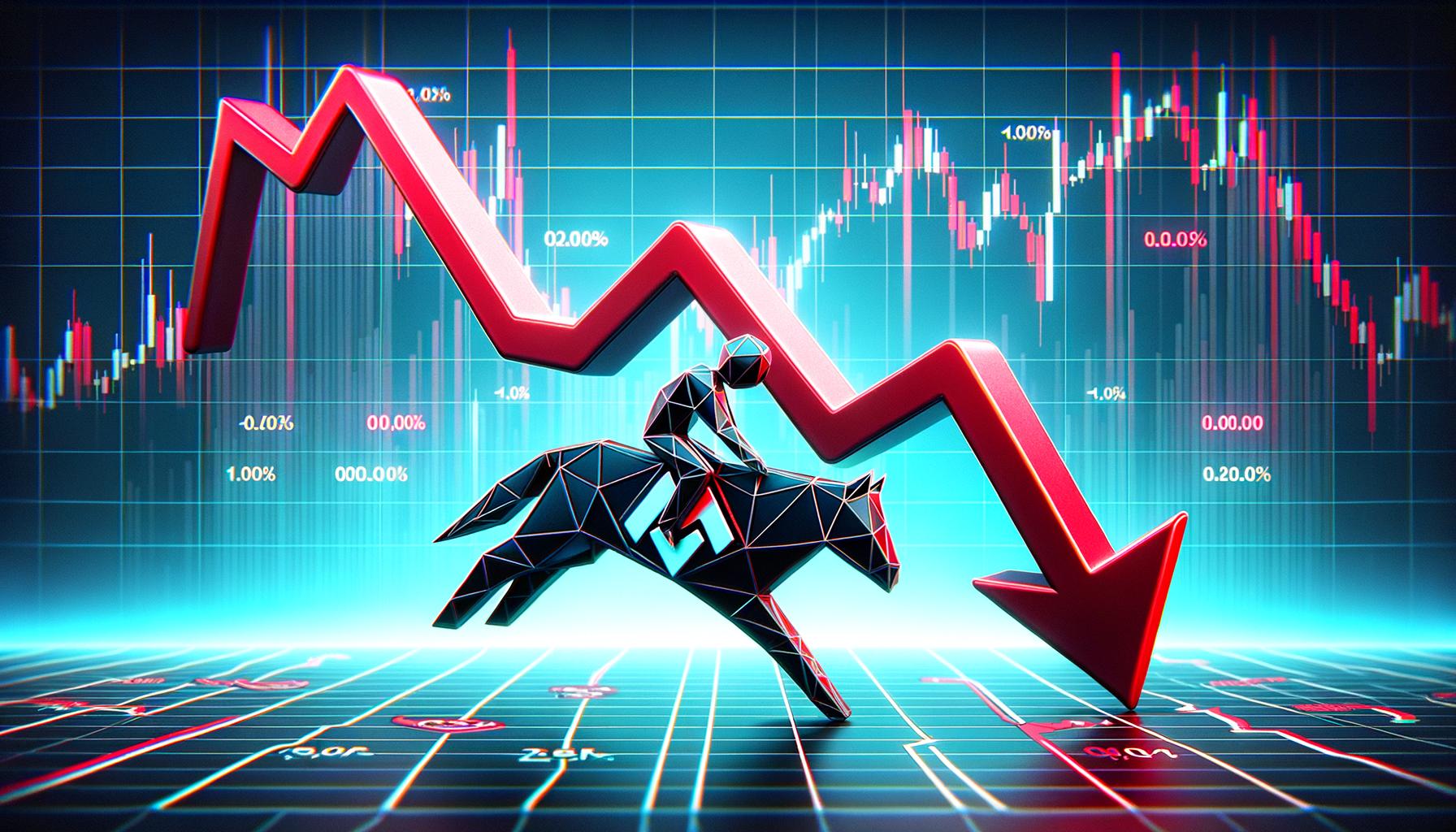
Cardano price started a recovery wave above the $0.680 zone but failed. ADA is consolidating near $0.650 and remains at risk of more losses.
- ADA price failed to recover above the $0.70 resistance zone.
- The price is trading below $0.680 and the 100-hourly simple moving average.
- There was a break below a connecting bullish trend line with support at $0.6720 on the hourly chart of the ADA/USD pair (data source from Kraken).
- The pair could start another increase if it clears the $0.70 resistance zone.
Cardano Price Dips Again
In the past few days, Cardano saw a recovery wave from the $0.6350 zone, like Bitcoin and Ethereum. ADA was able to climb above the $0.680 and $0.6880 resistance levels.
However, the bears were active above the $0.70 zone. A high was formed at $0.7090 and the price corrected most gains. There was a move below the $0.650 level. Besides, there was a break below a connecting bullish trend line with support at $0.6720 on the hourly chart of the ADA/USD pair.
A low was formed at $0.6356 and the price is now consolidating losses near the 23.6% Fib retracement level of the recent decline from the $0.7090 swing high to the $0.6356 low. Cardano price is now trading below $0.680 and the 100-hourly simple moving average.
On the upside, the price might face resistance near the $0.6720 zone or the 50% Fib retracement level of the recent decline from the $0.7090 swing high to the $0.6356 low. The first resistance is near $0.6950. The next key resistance might be $0.700.
If there is a close above the $0.70 resistance, the price could start a strong rally. In the stated case, the price could rise toward the $0.7420 region. Any more gains might call for a move toward $0.7650 in the near term.
Another Drop in ADA?
If Cardano’s price fails to climb above the $0.6720 resistance level, it could start another decline. Immediate support on the downside is near the $0.6420 level.
The next major support is near the $0.6350 level. A downside break below the $0.6350 level could open the doors for a test of $0.620. The next major support is near the $0.60 level where the bulls might emerge.
Technical Indicators
Hourly MACD – The MACD for ADA/USD is losing momentum in the bearish zone.
Hourly RSI (Relative Strength Index) – The RSI for ADA/USD is now below the 50 level.
Major Support Levels – $0.6420 and $0.6350.
Major Resistance Levels – $0.6720 and $0.7000.
Market
XRP Price Under Pressure—New Lows Signal More Trouble Ahead

Aayush Jindal, a luminary in the world of financial markets, whose expertise spans over 15 illustrious years in the realms of Forex and cryptocurrency trading. Renowned for his unparalleled proficiency in providing technical analysis, Aayush is a trusted advisor and senior market expert to investors worldwide, guiding them through the intricate landscapes of modern finance with his keen insights and astute chart analysis.
From a young age, Aayush exhibited a natural aptitude for deciphering complex systems and unraveling patterns. Fueled by an insatiable curiosity for understanding market dynamics, he embarked on a journey that would lead him to become one of the foremost authorities in the fields of Forex and crypto trading. With a meticulous eye for detail and an unwavering commitment to excellence, Aayush honed his craft over the years, mastering the art of technical analysis and chart interpretation.
As a software engineer, Aayush harnesses the power of technology to optimize trading strategies and develop innovative solutions for navigating the volatile waters of financial markets. His background in software engineering has equipped him with a unique skill set, enabling him to leverage cutting-edge tools and algorithms to gain a competitive edge in an ever-evolving landscape.
In addition to his roles in finance and technology, Aayush serves as the director of a prestigious IT company, where he spearheads initiatives aimed at driving digital innovation and transformation. Under his visionary leadership, the company has flourished, cementing its position as a leader in the tech industry and paving the way for groundbreaking advancements in software development and IT solutions.
Despite his demanding professional commitments, Aayush is a firm believer in the importance of work-life balance. An avid traveler and adventurer, he finds solace in exploring new destinations, immersing himself in different cultures, and forging lasting memories along the way. Whether he’s trekking through the Himalayas, diving in the azure waters of the Maldives, or experiencing the vibrant energy of bustling metropolises, Aayush embraces every opportunity to broaden his horizons and create unforgettable experiences.
Aayush’s journey to success is marked by a relentless pursuit of excellence and a steadfast commitment to continuous learning and growth. His academic achievements are a testament to his dedication and passion for excellence, having completed his software engineering with honors and excelling in every department.
At his core, Aayush is driven by a profound passion for analyzing markets and uncovering profitable opportunities amidst volatility. Whether he’s poring over price charts, identifying key support and resistance levels, or providing insightful analysis to his clients and followers, Aayush’s unwavering dedication to his craft sets him apart as a true industry leader and a beacon of inspiration to aspiring traders around the globe.
In a world where uncertainty reigns supreme, Aayush Jindal stands as a guiding light, illuminating the path to financial success with his unparalleled expertise, unwavering integrity, and boundless enthusiasm for the markets.
-

 Market23 hours ago
Market23 hours agoBNB Price Faces More Downside—Can Bulls Step In?
-

 Bitcoin24 hours ago
Bitcoin24 hours agoTokenized Gold Market Cap Tops $1.2 Billion as Gold Prices Surge
-

 Regulation18 hours ago
Regulation18 hours agoKraken Obtains Restricted Dealer Registration in Canada
-

 Altcoin14 hours ago
Altcoin14 hours agoHere’s Why This Analyst Believes XRP Price Could Surge 44x
-
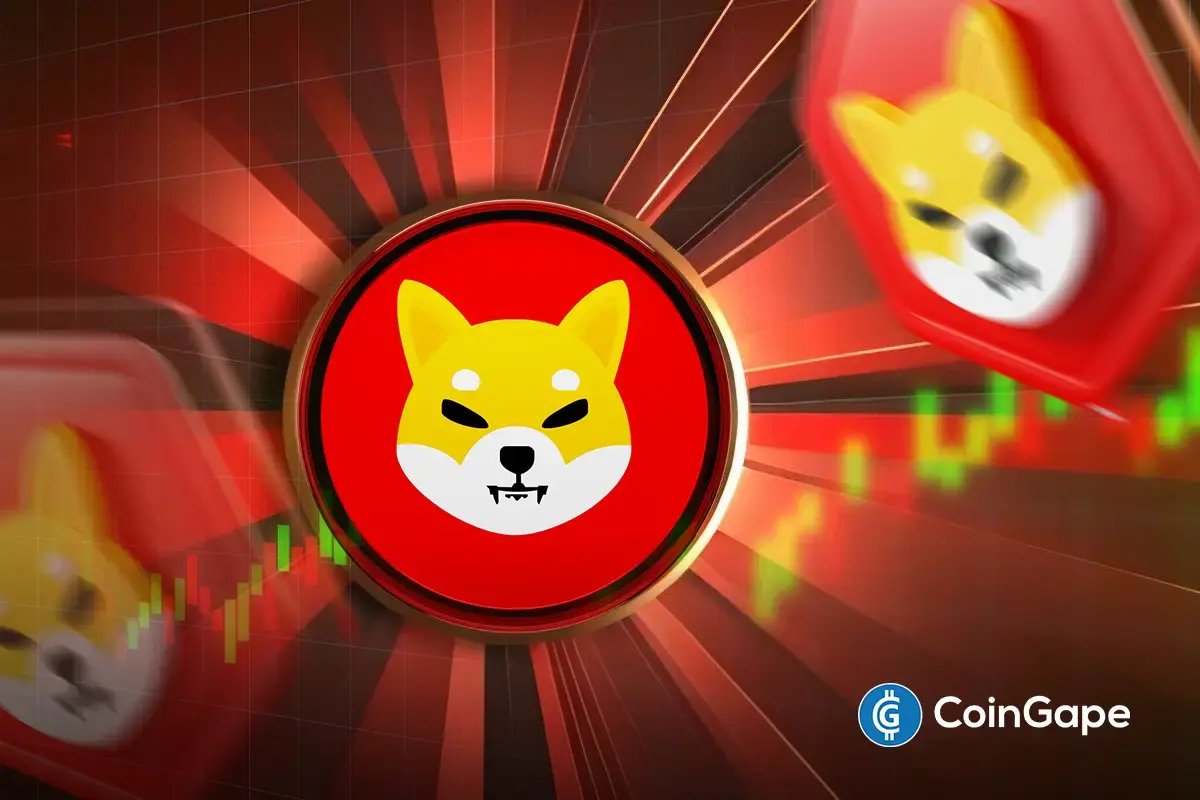
 Altcoin22 hours ago
Altcoin22 hours agoWhat’s Fueling The Shibarium Boost?
-

 Bitcoin20 hours ago
Bitcoin20 hours agoLummis Confirms Treasury Probes Direct Buys
-

 Altcoin13 hours ago
Altcoin13 hours agoHow Will Elon Musk Leaving DOGE Impact Dogecoin Price?
-

 Altcoin10 hours ago
Altcoin10 hours agoFirst Digital Trust Denies Justin Sun’s Allegations, Claims Full Solvency



